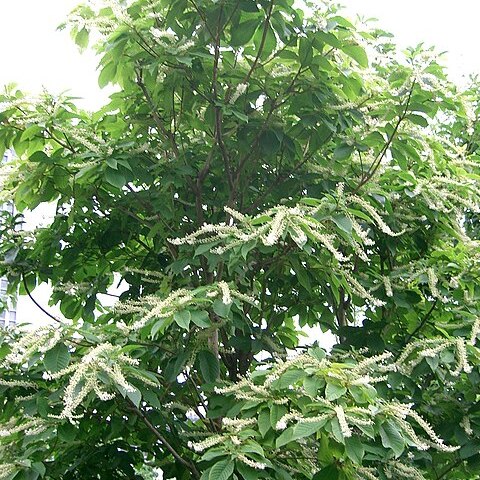Trees or shrubs, 1–9 m tall, deciduous. Petiole 0.6–2.4 cm; leaf blade ovate, lanceolate-ovate, elliptic, oblanceolate, or obovate, 5.2–11 × 2.8–4.8 cm, papery, abaxially appressed pilose or glabrous on major veins and often stellate-tufted in secondary vein axils, glabrous elsewhere, and reticulations dark brown but not raised, base attenuate to cuneate or occasionally obtuse to subrounded, margin sharply serrate nearly throughout or basal 1/4–1/3 entire, teeth 22–39 per side on larger leaves and 1–4 mm apart, apex acuminate; secondary veins (8–)11–14 on each side of midvein. Racemes or raceme branches (1–)3–8 per twig, 5–17 cm, grayish brown or brown stellate-tomentose but sometimes sparsely so, thickest rachis on each twig basally 0.8–1.7 mm in diam.; bracts linear-subulate, 3–6 mm. Pedicel 1.5–5.5 mm at anthesis. Sepals ovate, 2–3(–3.8) × 1.2–1.6 mm, outside densely white stellate-tomentose and surface (visible through pubescence) usually medially blackened, midvein usually indistinct at anthesis, apex obtuse. Petals white, 3–4 × 2–2.9 cm, outside smooth, inside glabrous, margin thickened and apically fimbriate. Stamens 4–5.3 mm, exserted; filaments glabrous or occasionally sparsely pilose; anthers 1.3–2 mm. Style 1.5–3.5 mm at anthesis, glabrous, apex 3-lobed to shallowly 3-cleft. Fruiting pedicel 4–9 mm. Ovary and capsule apically hirsute with longer hairs 0.7–1.1 mm; persistent style 3–5 mm. Fl. Jun–Aug, fr. Sep–Nov. 2n = 32.
More
A tree. It grows to 3-9 m high. In cultivation it is often only 3 m high. The bark is orange-brown and peeling. The shoots arch outwards. The leaves are dark green. The leaves have strong veins. There are very short hairs on the veins. The flowers appear in clusters at the tips of the branches. The flowers are white and in racemes at the ends of branches.
It is a warm temperate plant. In China it grows in open, deciduous mountain forests between 800-1,800 m above sea level. It grows in mountain woodlands in Japan. It suits hardiness zones 8-9.
More
Wooded hills and mountains all over Japan. In sunny deciduous forests on mountains, more or less stony and dry places at elevations of 1000-1500 metres.


